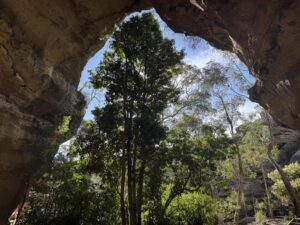
University of Sydney—Archaeologists from the Australian Museum, the University of Sydney and the Australian National University in collaboration with First Nations community members have unearthed 693 stone artefacts dating from the last Ice Age to the recent past. Found in an ancient Blue Mountains cave known as Dargan Shelter, this new evidence provides definitive proof of repeated occupation in this once frozen, high-altitude landscape.
The research*, funded by the Australian Museum Foundation, is published in Nature Human Behaviour today.
The Blue Mountains, home to some of the oldest known rock shelters in Australia, have been inhabited for over 30,000 years but this is the highest cave found showing past human activity.
Dating back 20,000 years, when the upper reaches of the Blue Mountains were treeless and seasonally frozen over, Dargan Shelter at 1073m elevation is believed to be the oldest occupied high-altitude landscape in Australia. Until now, researchers thought the Australian high country was too difficult to occupy during the last Ice Age. However, these new archaeological results provide the first evidence of repeated human activity and adaption to periglacial environments on the Australian continent.
Gomeroi knowledge holder and First Nations mentor in archaeology at the University of Sydney, Wayne Brennan, who is a rock art specialist, initiated the research project. Mr Brennan united scientists with First Nations community to explore the cultural history of the Blue Mountains and to improve conservation outcomes for this important cultural landscape.
Mr Brennan and lead author of the research paper Dr Amy Mosig Way, who holds a joint position as archaeologist at the Australian Museum and lecturer in Archaeology at the University of Sydney, worked closely with First Nations members from the Dharug, Wiradjuri, Dharawal, Gomeroi, Wonnarua, and Ngunnawal groups, who hold traditional connections to the region.
Dr Way said the research indicates that First Nations ancestors were able to navigate and occupy high-altitude periglacial environments during the Ice Age.
“This new evidence aligns Australia with global data that shows glacial landscapes were not necessarily natural barriers to early human movement and occupation,” Dr Way said.
“Until now, we thought the Australian high country was too difficult to occupy during the last Ice Age. Yet, despite the harsh conditions, our research demonstrates people were moving in and through this high elevation landscape, which is approximately 400m above the tree line.”
Second author of the paper, Professor Philip Piper from the School of Archaeology and Anthropology at the Australian National University, said the excavations uncovered an incredible depositional sequence of in situ human activity, including hearth features.
“It was the excellent state of preservation that enabled us to construct such a robust chronology for Dargan Shelter spanning the last 20,000 years,” Professor Piper said.
First Nations custodians, authors on the research paper and proud Dharug women, Leanne Watson Redpath and Erin Wilkins explained that their communities have lived in the Blue Mountains for thousands of years.
“Our people have walked, lived and thrived in the Blue Mountains for thousands of years and we knew the cave was there. It is not only a tangible connection to our ancestors who used it as a meeting place for sharing, storytelling and survival, but is a part of our cultural identity. We need to respect and protect our heritage for the benefit of all Australians,” Watson Redpath said.
“While there’s no certain way of identifying which groups accessed the mountains in the deep past, it is likely that multiple groups were connected to this country. Today, Dargan Shelter is considered by local custodians to represent a family space of high cultural significance,” said Erin Wilkins.
“The Blue Mountains is a UNESCO World Heritage listed site for the protection of flora and fauna but there are no safeguards for our cultural heritage. We hope that by combining our traditional knowledge with scientific research, we can protect these invaluable storehouses of our history for generations to come,” Brennan said.
Dr Way said the study builds on research conducted by Australian Museum archaeologists, beginning with Frederick McCarthy in 1935, Professor Paul Taçon and, most recently, Dr Val Attenbrow, augmenting previous findings and collections within the Australian Museum.
Advancing Indigenous Australian archaeology
The University of Sydney is deeply committed to First Nations archaeology. Dr Way and Mr Brennan are funded by the Tom Austen Brown Bequest which advances research and teaching in Indigenous Australian and other archaeologies.
Dr Way also coordinates an undergraduate unit titled Archaeology in the Field (ARCO3404). Third-year students from this unit, along with students from Australian National University, participated in the excavation of the Dargan Shelter and contributed to its broader research program.
Mr Brennan, a proud Gomeroi man and First Nations mentor in the Discipline of Archaeology, provides ongoing support and guidance to First Nations students studying archaeology. He also supports non-Indigenous students working with First Nations communities and collections, fostering respectful and collaborative engagement.
______________________________

Dargan Shelter, ancient cave in Blue Mountains, Australia. University of Sydney
______________________________

Hammerstone made of exotic black quartzite, unique to the Late Pleistocene assemblage at Dargan Shelter. The black quartzite was geochemically matched to river pebbles in the Hunter valley, approximately 150km to the north of the site. It was found in Layer 10, which dated to 15,000 years ago. University of Sydney
______________________________

Early Holocene basalt anvil found in layer 8 (8,990-8,610 cal. BP). It consisted of a split river pebble with distinctive sub-circular impact marks consistent with cracking hard wood nut and seed shells. University of Sydney
______________________________
Article Source: University of Sydney news release.
*The earliest evidence of high-elevation ice age occupation in Australia, Nature Human Behaviour, 16-Jun-2025. 10.1038/s41562-025-02180-y




